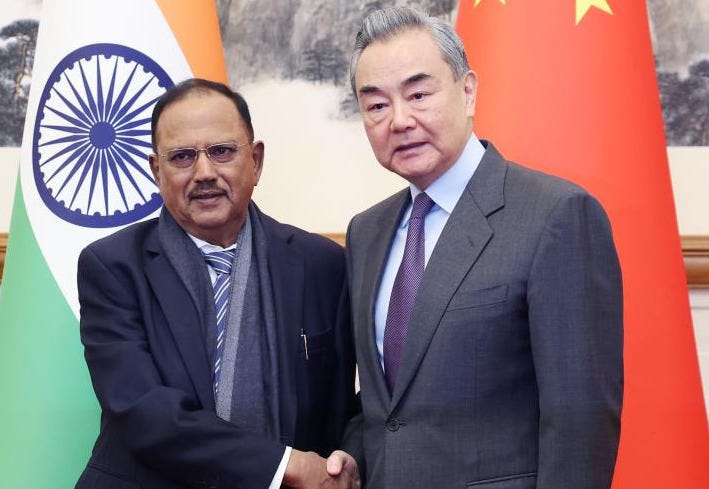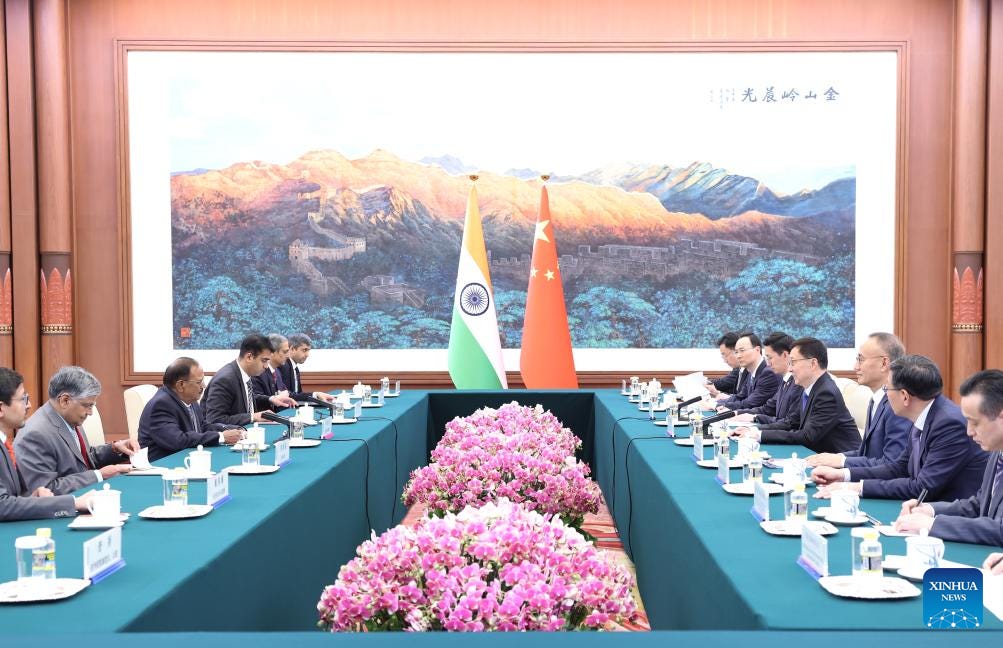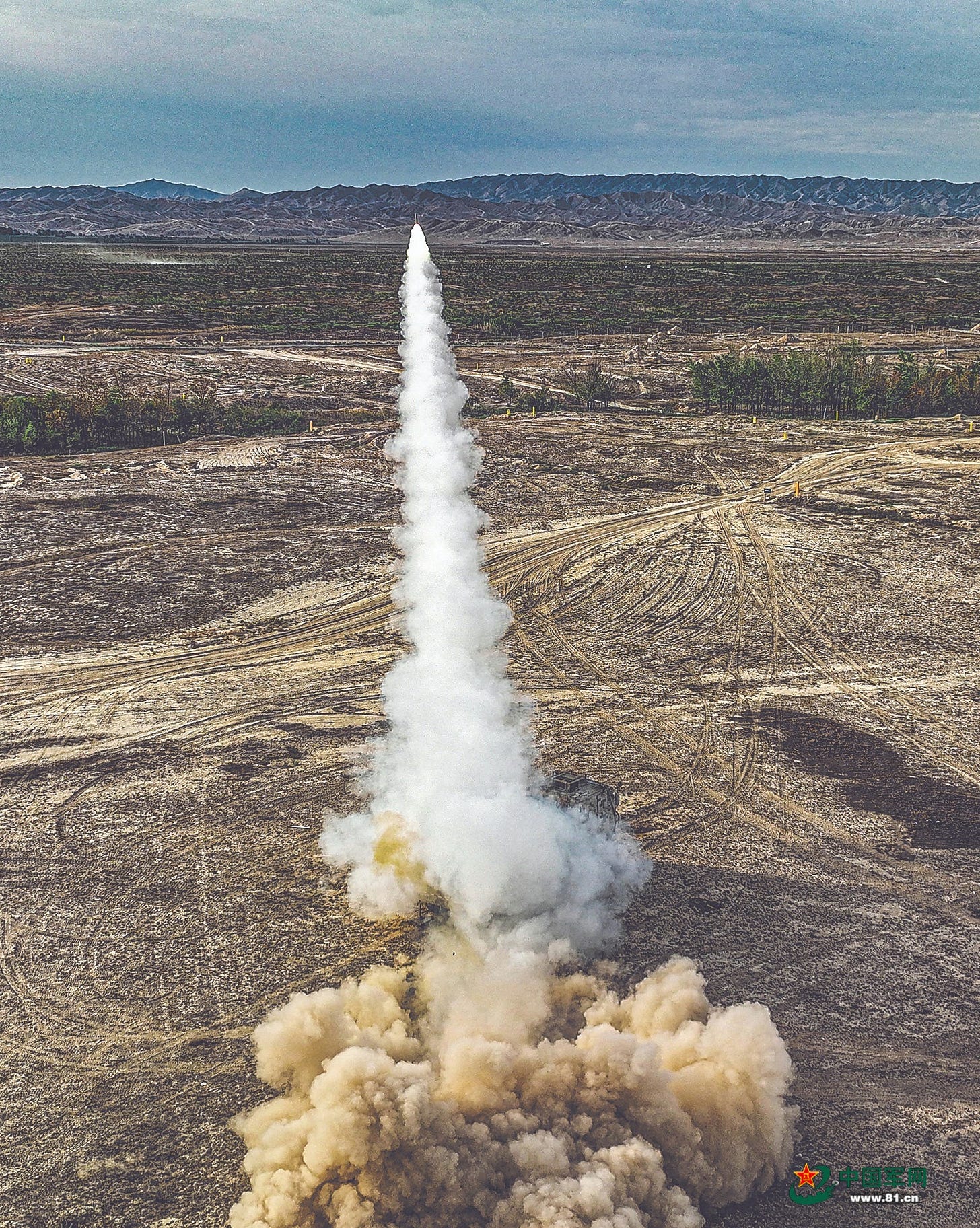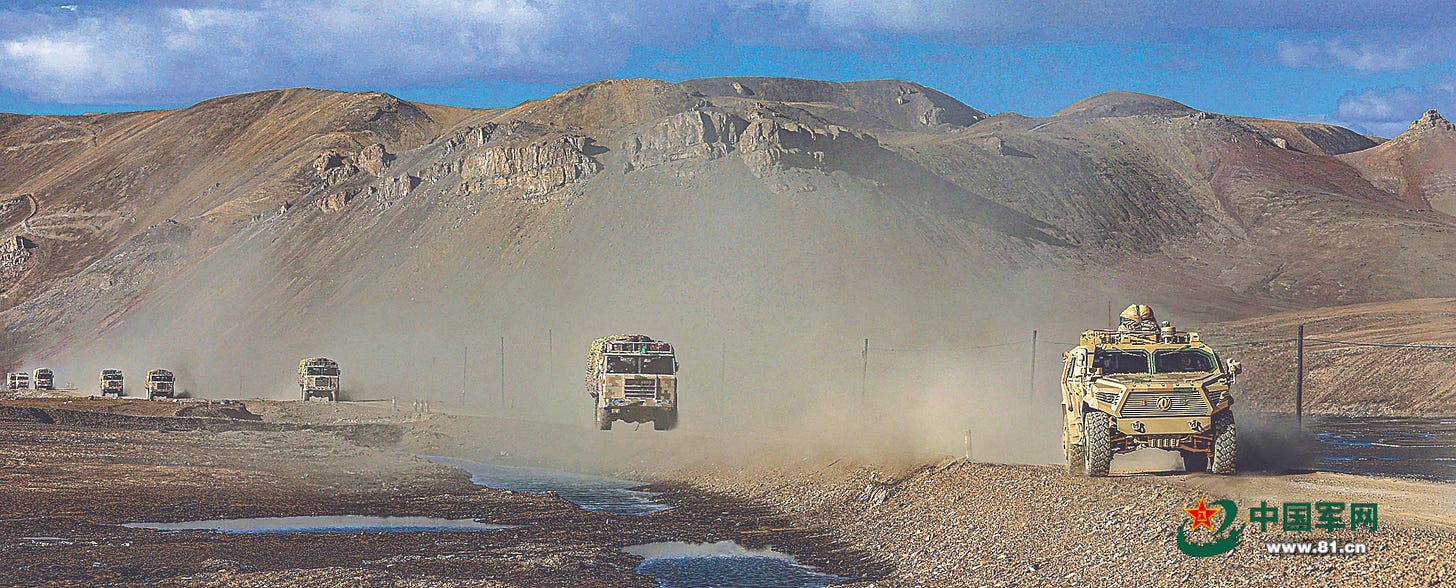China's military exercises in Ladakh continue despite talks
Asia Communique — The shifting dynamic of power in Asia
Hello Readers,
India’s National Security Advisor (NSA), Ajit Doval, visited Beijing on December 18, 2024, to engage in high-level talks aimed at resolving the prolonged border dispute between India and China. This visit marked the first formal dialogue between the two nations’ special representatives in five years, signaling a potential thaw in bilateral relations.
But the visit has left many wondering if India and China are making progress with a “reset” in their bilateral relationship.
High-level diplomatic talks may signal some progress in reducing tensions, but we should once again examine China’s actions. In the newsletter, I will describe the evidence that shows no change in China’s overall military strategy in Ladakh.
I will also share my assessment on where things stand.
A day after National Security Advisor Ajit Doval held talks with Chinese Foreign Minister Wang Yi, the People’s Liberation Army Daily published a news story about live-fire exercises by Xinjiang Military District. The story was prominently carried on the 9th page of the newspaper.
A rocket artillery unit of a firepower regiment of the 8th Combined Arms Division (Xinjiang Military District) carried out an exercise near Eastern Ladakh.
“During the training, the regiment closely followed actual combat, focusing on and refining multiple aspects such as information communication, reconnaissance and intelligence, command and control, to enhance the officers and soldiers' ability to coordinate operations and carry out precision strikes” said the PLA Daily on December 19.
Original Chinese text: 训练中,该团紧贴实战,围绕信息通信、侦察情报、指挥控制等多个环节专攻精练,提升官兵协同作战和精准打击能力。
The images published in the PLA Daily show 6x6 122mm PHL-11 MLRS.
The PHL-11 is a Chinese truck-mounted self-propelled 122mm multiple rocket launcher system developed by Norinco for the People’s Liberation Army Ground Force (PLAGF). It serves as a modernized replacement for the older PHL-81 system.
Design and Features:
• Armament: The PHL-11 is equipped with 40 launch tubes arranged in two pods of 20 rockets each. It can fire a full salvo of 40 rockets within 30 seconds, delivering substantial firepower over a wide area.
• Range: Standard 122mm rockets have an effective range between 20 to 40 kilometers. With extended-range ammunition, the system can achieve ranges up to 50 kilometers, allowing for greater operational flexibility.
• Chassis: Mounted on a 6x6 Shaanxi SX2190KA truck chassis, the PHL-11 is powered by a 206 kW Weichai WD615-77A diesel engine, enabling a top speed of 80 km/h and providing excellent off-road mobility. The vehicle’s design includes armor plates on windows for crew protection.
The PLA continues to exercise actual combat scenarios which are quite evidently meant to counter India.
Images of the live-fire test with PHL-11 MLRS
Interestingly, the PLA tried to blur the images and the test wasn’t broadcast on the CCTV military channel. The choice of highlighting the exercise in PLA Daily and Xinhua would be to send an official signal to New Delhi that the troops remain depolyed in the area.
Beijing isn’t hiding its intensions to continue military activity across from Ladakh.
The news story was also carried by Xinhua.
Beijing wants to maintain pressure on New Delhi as it views that India has limited options at this point. The changing geopolitical environment has brought New Delhi to the table but Beijing will use the opportunity to consolidate its claims.
China has moved its troops to a new location behind the position where the disengagement took place. This is an established fact that many analysts have confirmed.
Meanwhile, China has carried out a series of exercises in minus-20 weather with small rifles at locations in Aksai Chin. These exercises took place as part of the end-of-the-year military assessment.
As I have said earlier, China’s investment in military and dual-use infrastructure in the Ladakh wouldn’t be reversed anytime soon. China’s strategy with the talks is to cement their claims on the ground while further strengthening militarty infrastrcture
Meanwhile, the Hindustan Times has reported, citing satellite imagery, that China has built 22 new villages and settlements over the past eight years. The newspaper reports these villages are within the traditional territory of Bhutan.
“Ashok Kantha, who served as India’s envoy to Beijing during 2014-16 and is an honorary fellow at the Institute of Chinese Studies, said China’s construction of villages within Bhutanese territory amounted to a violation of the agreement signed by the two countries in December 1998 on peace and tranquillity in border areas,” The Hindustan Times has reported.
The newspaper also cites Robert Barnett’s recent report on construction of China’s villages on Bhutanese territory: Forceful Diplomacy: China’s Cross-Border Villages in Bhutan
In a recent meeting, Xi underscored the importance of continuing the work of boosting security at the border.
On December 9, the Political Bureau of the CPC Central Committee convened its 18th collective study session, focusing on the historical trajectory of border governance in China. Under the leadership of Xi Jinping, General Secretary of the CPC Central Committee, the session underscored the critical role of modernizing border governance systems and enhancing governance capabilities as integral components of the broader framework of Chinese-style modernization.
“Xi Jinping delivered an important speech after listening to the explanation and discussion. He pointed out that since the 18th CPC National Congress, the CPC Central Committee has focused on the overall strategic situation of governing the country, put forward a series of important propositions and major measures such as "governing the country requires governing the border", "developing the border and enriching the people, stabilizing the border and consolidating the border", adhered to and improved the regional coordinated development strategy and major regional strategies, accelerated the high-quality development of border areas, promoted border areas to win the battle against poverty, build a well-off society in an all-round way, and embark on a new journey of building a modern socialist country in an all-round way together with the whole country, and achieved historic achievements and historic changes in border governance”
“Xi Jinping pointed out that we must insist on maintaining national security and social stability as the bottom line requirement for border governance. We must improve the social governance system of co-construction, co-governance and sharing, continuously consolidate the grassroots foundation, and improve the effectiveness of social governance in border areas. We must strengthen infrastructure construction, strengthen scientific and technological empowerment, and improve the overall ability to defend the country and guard the border”
Xi’s statement during the Politburo study session suggests that China will continue the village construction despite holding talks with New Delhi.
At the meeting, Comrade Li Guoqiang, a member of the Chinese Academy of Social Sciences and vice president of the Chinese Academy of History, presented a detailed report. Li’s report and Xi’s remarks suggest that China will enhance its efforts to rewrite the history of border areas to consolidate its claims.
Xi remains cognizant that border areas remain unintegrated into the Chinese Communist Party’s terminology, and a continuous effort needs to be made to create a theoretical basis for integrating these areas.
Coming back to Doval’s China visit.
Full text of India and China's six-point consensus during Doval’s visit to Beijing.
In the text, China mentioned the 2005 agreement on border management, emphasizing that border issues shouldn’t drive the overall bilateral relationship. On Friday, the Ministry of External Affairs distanced itself from China’s emphasis on the “six-point consensus” while saying, “The two sides have reaffirmed their commitment to exploring a fair, reasonable, and mutually acceptable framework for the settlement of the boundary question by the political parameters and guiding principles agreed in 2005.”
MEA’s press release on the visit doesn’t mention the 2005 agreement or the six-point consensus that Beijing mentioned. China mentioned a “package solution” in its statement, Beijing’s attempt to combine multiple issues.
There are already apparent fissures between New Delhi and Beijing on the way forward.
So what does Ajit Doval’s China visit mean?
Overall, China is interested in resuming economic ties while giving India much-desired access to the Kailash Mansarovar and some breathing room in a complex geopolitical environment.
China wants to resume business as usual while continuing to strengthen its claims in Ladakh. Since the political leadership is driving the talks from New Delhi’s side, there is some interest in creating space for itself in the currently complex geopolitical environment through talks with Beijing.
But tactically, little has changed for New Delhi, which hopes that a new geopolitical scenario in the near future will allow it to negotiate a deal on Ladakh. As recent history shows, betting on hope for a settlement with Beijing hasn’t yielded any results.
These talks show that New Delhi might be at a disadvantage by holding such high-level talks as Beijing seems to be successful at brushing the issue of Ladakh under the carpet. The strategy of coupling the current tension as a future “package deal” only distracts from current situation.
New Delhi’s efforts to highlight China’s actions at the border will only become difficult as Beijing appears to strengthen its narrative that two sides have put their tensions aside.
Any thoughts? Feel free to get in touch.








